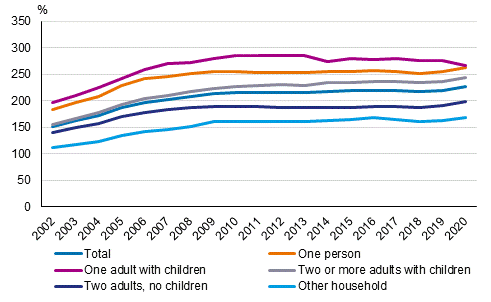Published: 17 December 2021
Average indebtedness ratio of household dwelling units with housing loans 227 percent
Household-dwelling units with housing loans had, on average, 227 per cent of their disposable annual income in debts in 2020. Household-dwelling units with one adult and at least one child had the largest debts relative to their income, 267 per cent. One-person households had 262 per cent debt relative to disposable income. The indebtedness ratio of two-adult families with children was also higher than average, 243 per cent of income. In 2020, the indebtedness ratio of all household-dwelling units was 114 per cent. The indebtedness ratio was three percentage points higher than in 2019.
Rates of indebtedness of household-dwelling units with housing loans by type of family in 2002 to 2020, %

In 2020, there were 1.46 million indebted household-dwelling units, that is, 53 per cent of all household-dwelling units. The total debt of indebted household-dwelling units amounted to EUR 131.6 billion, which in real terms was 3.4 per cent more than in 2019.
For close on one-fifth of indebted household-dwelling units, that is, 277,770 household-dwelling units, debts were at least three times as high as their annual income. Their debts accounted for 50.4 per cent of all debts. In all, 72,860 household-dwelling units or five per cent of indebted household-dwelling units had debts that were at least five times as high as their annual income. These household-dwelling units accounted for 18.6 per cent of all debts of household-dwelling units.
Large debts were most common in household-dwelling units where the reference person was aged 35 to 44. In all 94,660, or 29 per cent, of indebted household-dwelling units in this age group had debts that were at least three times as high as their annual income. The share of household-dwelling units with debts at least three times as high as their annual income of all indebted household-dwelling units was also almost as high in the age group 25 to 34. In this age group, 86,230 household-dwelling units, or 28 per cent, had debts at least triple relative to their annual income.
Household-dwelling units with housing loans with a debt at least three times as high as their annual income numbered 258,560, or 30 per cent of household-dwelling units with housing loans in 2020. Large debts were most common in household-dwelling units in Åland and Greater Helsinki. Forty-two per cent of household-dwelling units with housing loans in Greater Helsinki and Åland had debts at least three times as high as their annual income. In the rest of Helsinki-Uusimaa, too, 34 per cent of household-dwelling units with housing loans had debts at least triple relative to their annual income, which exceeded the share for the whole country. The shares of large debts were lowest in the areas of the rest of Southern Finland and Northern and Eastern Finland, where around one fourth of household-dwelling units with housing loans had an amount of debts triple compared to their annual income.
Forty-one per cent of household-dwelling units with housing loans belonging to the lowest income quintile had debts at least three times as high as their annual income. In other income quintiles, the share of large debts varied from 32 per cent in the second lowest income quintile to 27 per cent in the highest income quintile.
Source: Indebtedness 2020. Statistics Finland
Inquiries: Ossi Kohvakka 029 551 3534
Head of Department in charge: Hannele Orjala
- Tables
-
Tables in databases
Pick the data you need into tables, view the data as graphs, or download the data for your use.
Updated 17.12.2021
Official Statistics of Finland (OSF):
Indebtedness [e-publication].
ISSN=2489-3285. 2020. Helsinki: Statistics Finland [referred: 17.7.2024].
Access method: http://www.stat.fi/til/velk/2020/velk_2020_2021-12-17_tie_002_en.html

